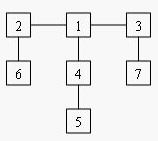Balancing Act
| Time Limit: 1000MS |
Memory Limit: 65536K |
|
| Total Submissions: 16866 |
Accepted: 7130 |
Description
Consider a tree T with N (1 <= N <= 20,000) nodes numbered 1...N. Deleting any node from the tree yields a forest: a collection of one or more trees. Define the balance of a node to be the size of the largest tree in the forest T created by deleting that node from T.
For example, consider the tree:

Deleting node 4 yields two trees whose member nodes are {5} and {1,2,3,6,7}. The larger of these two trees has five nodes, thus the balance of node 4 is five. Deleting node 1 yields a forest of three trees of equal size: {2,6}, {3,7}, and {4,5}. Each of these trees has two nodes, so the balance of node 1 is two.
For each input tree, calculate the node that has the minimum balance. If multiple nodes have equal balance, output the one with the lowest number.
Input
The first line of input contains a single integer t (1 <= t <= 20), the number of test cases. The first line of each test case contains an integer N (1 <= N <= 20,000), the number of congruence. The next N-1 lines each contains two space-separated node numbers that are the endpoints of an edge in the tree. No edge will be listed twice, and all edges will be listed.
Output
For each test case, print a line containing two integers, the number of the node with minimum balance and the balance of that node.
Sample Input
1
7
2 6
1 2
1 4
4 5
3 7
3 1
Sample Output
1 2
Source
POJ Monthly--2004.05.15 IOI 2003 sample task
算法分析:
num[i] 保存自己所有除祖先以外所有子树的节点总和,dp[i]保存所有子树中最大的子树的节点数,
代码实现:
#include <stdio.h>
#include <string.h>
#include <iostream>
#include <algorithm>
#include <stack>
#include <vector>
#include <queue>
#include <set>
#include <map>
#include <string>
#include <math.h>
#include <stdlib.h>
#include <time.h>
using namespace std;
const int N=20010;
struct node
{
int v;///终端点
int next;///下一条同样起点的边号
int w;///权值
}edge[N*2];///无向边,2倍
int head[N];///head[u]=i表示以u为起点的所有边中的第一条边是 i号边
int tot; ///总边数
void add(int u,int v)
{
edge[tot].v=v;
edge[tot].next=head[u];
head[u]=tot++;
}
int n;
int dp[N],num[N];
void dfs(int u,int fa) ///求出每个节点子树下的最大距离和次大距离
{
num[u]=1;
for(int i=head[u];i!=-1;i=edge[i].next)
{
int v= edge[i].v;
if(fa==v) continue;
dfs(v,u);
dp[u]=max(dp[u],num[v]);
num[u]+=num[v];
}
dp[u]=max(dp[u],n-num[u]);
}
int main()
{
int t;
scanf("%d",&t);
while(t--)
{
scanf("%d",&n);
memset(head,-1,sizeof(head));
memset(dp,-1,sizeof(dp));
tot=0;
for(int i=1;i<n;i++)
{
int u,v;
scanf("%d%d",&u,&v);
add(u,v);
add(v,u);
}
dfs(1,-1);
int point;
int ans = 1e9;
for(int i = 1; i <= n; i ++)
{
if(dp[i] < ans)
{
point = i;
ans = dp[i];
}
}
printf("%d %d\n",point, ans);
}
return 0;
}

